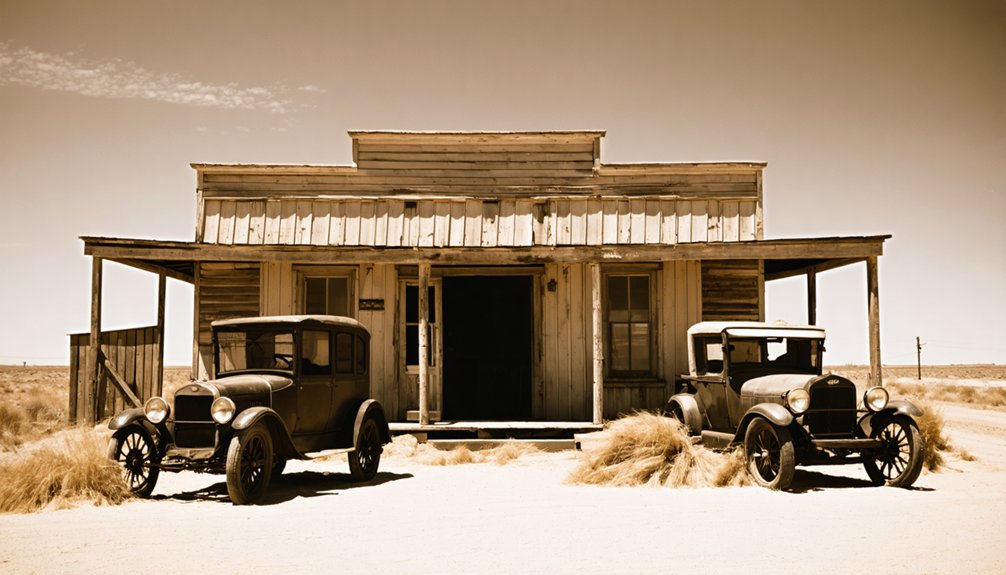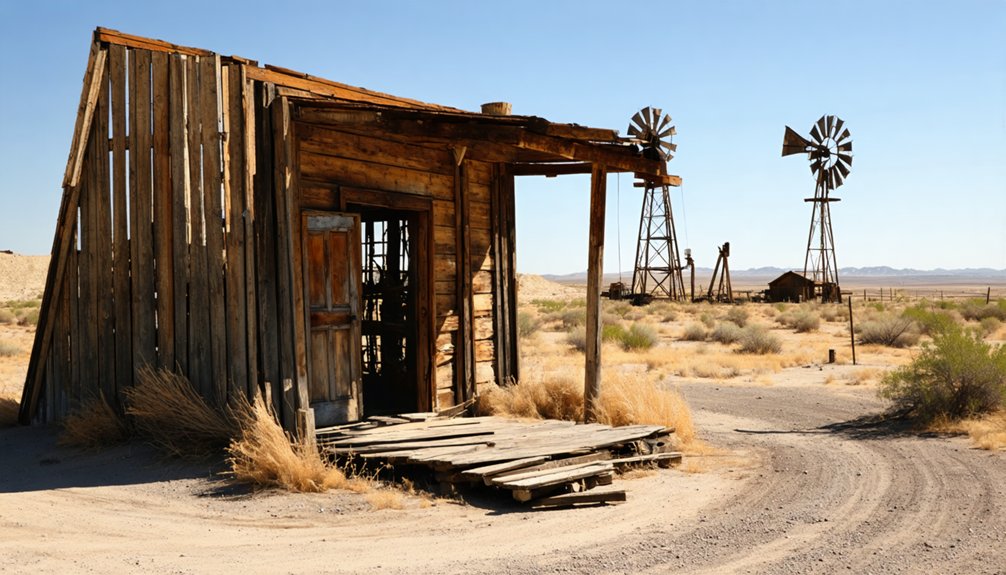You’ll find Soash’s haunting ruins 20 miles north of Big Spring, Texas, where William P. Soash’s ambitious frontier town stood from 1909 to 1917. The settlement featured a reinforced concrete bank and hotel, attracting settlers through “Soash Specials” excursion trains and aggressive marketing campaigns. Despite early promise, the town’s fate was sealed when the Santa Fe railroad chose nearby Lamesa instead, and devastating droughts forced residents to abandon their dreams. The ghostly remains tell a cautionary tale of frontier development’s fragility.
Key Takeaways
- Soash was founded in 1909 by W.P. Soash as a land development project but failed by 1912 due to severe drought and railroad bypassing.
- The town’s remains include ruins of the Hotel Lorna and reinforced concrete Bank of Soash building, located 20 miles north of Big Spring.
- Originally marketed through “Soash Specials” train excursions, the town lost its post office in 1917 and was ultimately abandoned.
- A Texas Historical Marker now commemorates the site and founder William P. Soash, preserving its cultural significance.
- The town’s failure exemplifies how railroad access and environmental factors could determine the fate of early 20th-century Texas frontier communities.
The Rise of an Empire Builder’s Dream
When William Pulver Soash signed an agreement with Christopher Columbus Slaughter in 1909 to sell portions of the Long S Ranch, he set in motion an ambitious plan to transform West Texas ranch land into thriving communities. His empire aspirations led him to establish the W. P. Soash Land Company and the Lone Star Land Company, focusing on direct land sales to settlers without middlemen. Like the pioneers who built local capital railroads in East Texas, Soash relied heavily on community investment to fuel his development projects.
You’ll find that Soash’s vision extended beyond mere land development. He orchestrated “Soash Specials,” excursion trains that brought 75 to 150 prospective settlers at a time, eventually moving nearly 10,000 people to the region. The company’s promotional materials featured exaggerated artistic renderings to entice potential buyers to the untamed West.
Despite facing significant railroad challenges when the Santa Fe line chose Lamesa over his town, Soash persevered, having already proven his development expertise by founding Ware and securing its connection to the Fort Worth and Denver Railway.
From Prairie Promise to Financial Fallout
Though William P. Soash envisioned a thriving agricultural empire on Texas’ South Plains, his dream quickly crumbled under mounting financial challenges.
Despite grand visions of agricultural prosperity in Texas, Soash’s ambitious plans collapsed amid financial struggles on the harsh South Plains.
You’ll find that the W.P. Soash Company’s aggressive marketing campaigns couldn’t overcome the harsh realities that settlers faced.
Initial development brought a bank and hotel to the ambitious town site.
The Bank of Soash featured reinforced concrete construction to demonstrate permanence.
The agricultural decline became evident through:
- A devastating drought cycle starting in 1909 that destroyed crop yields
- The company’s bankruptcy filing in 1912, just three years after founding
- Two post office closures, with the final shutdown in 1917
Life in Early 20th Century Soash

Despite early optimistic visions, life in Soash during the early 1900s centered around a small but determined farming community carved from former ranch lands.
You’d find yourself among settlers drawn by William Soash’s ambitious land promotions, trying to establish farms on what was once the sprawling Slaughter and XIT ranches.
The community dynamics reflected typical prairie life – farmers and ranchers working side by side, sharing basic amenities like the local bank and office building.
Agricultural practices focused on corn cultivation and cattle raising, though persistent drought made farming challenging. The Hotel Lorna served as a central gathering spot for the community’s social activities.
While promotional trains brought potential settlers to view the promising landscape, the lack of a permanent railroad connection ultimately limited the town’s growth. The region’s average annual rainfall of 18.04 inches made sustainable farming particularly difficult for early settlers.
Legacy of a Lost Texas Town
The tale of Soash stands as a stark reminder of frontier development’s fragility in early 20th-century Texas. This cautionary tale of speculative ventures reveals how seemingly promising settlements could vanish when critical infrastructure and natural resources failed to materialize.
Failed dreams and vanished hopes scatter like dust across Texas’s frontier, where grand plans crumbled against harsh realities.
Today, you’ll find only concrete bank foundations where a bustling town once stood, but Soash’s legacy lives on through:
- Its demonstration of how railroad access could make or break frontier communities
- Its role in teaching future developers about the risks of overselling land without considering environmental factors
- Its continued presence in local street names and historical records around Lamesa and Big Spring
Among Texas’s 500+ ghost towns, Soash exemplifies the boom-and-bust cycle that shaped the state’s development, serving as a powerful reminder of nature’s dominance over human ambition.
Remnants and Remembrance Today
While most Texas ghost towns fade into obscurity, Soash’s physical remnants and historical recognition keep its memory alive today.
You’ll find the town’s legacy preserved through a Texas Historical Marker commemorating founder William P. Soash, while scattered ruins of the Hotel Lorna and company buildings stand as silent witnesses to its ambitious past.
Though ghost town tourism remains limited due to the remote location 20 miles north of Big Spring, passionate historians and photographers venture here to capture the town’s haunting beauty.
The Texas Historical Commission’s landmark designation in 1978 guarantees Soash’s preservation as part of the state’s cultural heritage.
Local historical societies continue documenting stories of the town’s grand 1909 founding celebration and its brief but colorful existence.
Frequently Asked Questions
What Happened to William Pulver Soash After the Town’s Failure?
After the town’s failure, you’d find William Pulver establishing Lone Star Land Company in Lubbock, continuing real estate ventures, serving as cavalry lieutenant, and leaving behind his town’s legacy until death in 1961.
Were There Any Successful Businesses in Soash During Its Brief Existence?
You’ll find that while businesses like the Hotel Lorna and post office operated briefly, none of these business ventures achieved lasting economic impact, failing within three years of the town’s founding.
How Many Residents Actually Lived in Soash at Its Peak?
You’d think someone would’ve counted heads in this dustbowl dream, but no official population peak was ever recorded. Town demographics remain a mystery despite historical research efforts.
Did Any Families From the Original Settlement Remain in the Area?
Historical records don’t show any family descendants remaining permanently in the area. You won’t find direct settler lineages there today, as most families departed during the devastating droughts and economic collapse.
What Natural Resources or Agricultural Products Were Prominent in Soash?
You’d think cotton production and mineral extraction would’ve thrived, but drought killed farming dreams. The only prominent resources were grasslands for cattle grazing, which couldn’t sustain the settlement either.
References
- https://blogs.baylor.edu/digitalcollections/2012/11/15/the-rise-and-fall-of-the-soash-empire-a-west-texas-hard-luck-story/
- https://www.lubbockonline.com/story/news/history/2023/06/17/caprock-chronicles-soash-the-city-of-the-plains/70324125007/
- https://kids.kiddle.co/Soash
- http://www.txgenweb.org/research/landmarks/howard.htm
- https://en.wikipedia.org/wiki/List_of_ghost_towns_in_Texas
- https://www.ghosttowns.com/states/tx/soash.html
- https://freepages.history.rootsweb.com/~gtusa/usa/tx/soash.htm
- https://www.tshaonline.org/handbook/entries/soash-tx
- https://www.texasescapes.com/TexasGhostTowns/Soash-Texas.htm
- https://www.wilsoncountyhistory.org/talk-railroads



